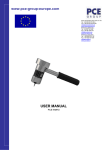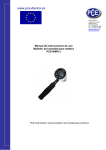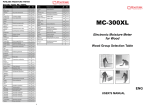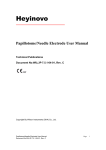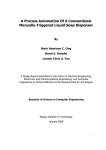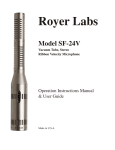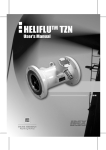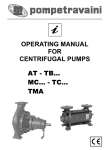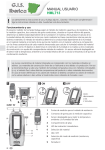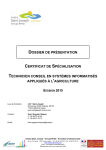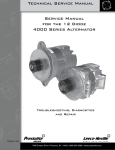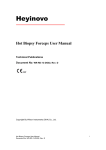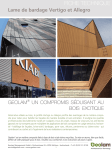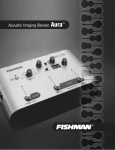Download the user`s manual
Transcript
www.pce-group-europe.com PCE- Deutschland Gmb H & Co. KG Tel: +49 029 03 976 99-0 Fax: +49 029 03 976 99-29 [email protected] www.warensortiment.de PCE Group Ibérica S.L. Tel: +34 967 543 548 Fax: +34 967 543 542 [email protected] www.pce-iberica.es PCE Group Italia S.R.L. Tel: + 39 0583 975 114 Fax: +39 0583 974 824 [email protected] www.pce-italia.it USER MANUAL PCE-HGP Contents: 1. Application.................................................................................................................3 2. Technical data ...........................................................................................................3 3. Measurements of wood moisture contents................................................................3 4. Measurements of building materials moisture contents ............................................4 5. Measurements of air humidity and temperature ........................................................5 6. Examples of application ............................................................................................5 6.1 Measurement of moisture contents in concrete floor. 6.2. Measurement of moisture contents in plaster. 6.3. Surface temperature measurement. 6.4. Dew point temperature measurement. 6.5. Measurement of moisture contents in exotic wood types. 6.6. Measurement of moisture contents in very dry wood. 7. Storage and batteries ................................................................................................6 8. Guarantee and repairs ..............................................................................................8 Attention: The device can be turned on and off by pressing and holding both SELECT and WOOD TEMP. Buttons simultaneously. Moisture Meter HYGROPEN is an electronic device and should be operated carefully and reasonably. 2 1. Application Moisture Meter HYGROPEN is a universal, state-of-the-art, electronic device for measuring moisture contents in wood, building materials and also air humidity and temperature. It is particularly useful for: wood moisture contents measurements. measurements of moisture contents in plywood (parquet) and concrete floors. evaluation of moisture contents in buildings. evaluation of atmospheric conditions (air humidity and temp.). Despite it’s small size the device provides results of very high accuracy. This is achieved by the usage of a special microprocessor and high quality humidity and temperature sensors. The device is very user friendly. The measurement of wood moisture contents includes wood type and temperature compensation. 2. Technical data Measuring range air humidity air temperature dew point temp. wood moisture contents building materials moisture contents 0 – 100 % RH -5ºC to 50ºC -9°C to 50°C 6 – 60% indicator Out of range indication below range over range yes LO HI Number of wood types 3 groups (12 types + 270 exotic types) Wood temp. range 0ºC - 50ºC (32ºF - 122ºF) Display LCD, dedicated Accuracy air humidity (in 20ºC) air temperature wood moisture contents ± 2% within range 20 – 85% ± 3% within ranges 0 - 20% and 85 - 100% ± 1ºC (±2ºF) ± 1% within range 6 – 15% ± 2% within range 16 – 28% over 28% - approx. Measurement. 3 Resolution air humidity air temperature wood moisture cont. Sensor types air humidity air temperature 0.5 % RH 0.5ºC (0.5°F) 0.1% capacitance (HUMIREL) resistance (HUMIREL) Power 12V (bat. 23A) Battery life 2000 measurements Auto power off yes, after 5 min. Low power indications yes Size 160 x 27 x 15 mm Guarantee 12 months 4 3. Measurements of wood moisture contents 3.1 Preparing the instrument for measurements To prepare the device for measurements of wood moisture contents proceed with the following steps: turn the device on by pressing both SELECT and WOOD TEMP. simultaneously. remove the cap protecting the needles. use SELECT to choose the appropriate group of wood types (WOOD 1 or WOOD 2 or WOOD 3); a table containing most popular wood types is on the back of the device. use WOOD TEMP. to select the measured or estimated wood temperature (the step is 5ºC). The selected temperature will be displayed in the upper left corner of the LCD. 3.2 Moisture contents measurement Slowly insert the needles into the wood. Do not use excessive force. A line connecting the needles should be perpendicular to the fibbers of the wood (fig. 3.1). For moisture con- tents below 20% the way of measuring (perpendicular or parallel to the fibbers) has no noticeable influence on the result. Fig. 3.1 If the wood is very hard and there is a danger of damaging (breaking) the device or the needles, use extra nails. Hammer two nails (1,5 mm thick) in the wood 15 mm apart and then touch the heads of the nails with the needles of the device (fig. 3.2). Read the result (for exotic wood types see chapter 6.5). Fig. 3.2 5 4. Measurements of building materials moisture contents The most commonly used method of measuring moisture contents in building materials (e.g. concrete, plaster, brick, gypsum) is based on the measurement of the resistance. Moisture Meter HYGROPEN is also based on that method. To measure (estimate) the moisture contents follow these steps: ¤ ¤ ¤ ¤ ¤ turn the device on by pressing both SELECT and WOOD TEMP. simultaneously. remove the cap protecting the needles. use SELECT to choose BUILD. MAT. ammer two nails (2-3 mm thick) in the floor 15 mm apart. touch the heads of the nails with the needles of the device and read the result. If the result is below 17.0 and there is a DRY sign displayed over it, it indicates that the floor is dry. If the result is between 17.0 and 20.0 and the signs DRY and WET are displayed alternately, it indicates that the floor is almost dry. If the result is over 20.0 and there is a WET sign displayed over it, it indicates that the floor is wet and requires additional drying. A very rough estimate of moisture contents in concrete can be calculated as ⅛ of the displayed result. Example: the result of 24.0 indicates that the moisture contents in concrete is approximately 24 : 8 =3.0%. 5. Measurements of air humidity and temperature Moisture Meter HYGROPEN can be used to measure relative humidity and temperature of the air. The sensors are located below the slits in the forward part of the device. To enable the air flow to the sensors move the cap half way or remove it completely. To measure relative humidity use SELECT to choose AIR RH. To measure temperature use SELECT to choose AIR TEMP. The LCD will present two numbers: ¤ in the middle – air temp. (°C), ¤ in the upper left corner – dew point temperature (°C) (see chapter 6.4 Dew point temperature measurement) Waiting for the results The general rule is to wait until the result stabilizes i.e. it practically stops changing. Waiting time is proportional to the difference between the temperature of the instrument and the temperature of the surrounding air. Correct results can be obtained no sooner than the temperature of the instrument’s case is equal to the temperature of the surrounding air. If the temperature of the case (and the temperature of the air inside the device around the sensors) is 1°C higher than the “real” temperature of the air in the room, the measured humidity will be 3% lower than the “real” one. Similarly if the temperature of the case is 1°C lower than the “real” one, the indicated humidity will be 3% higher than the “real” one. 6 As you can see the influence of temperature on the accuracy is very significant. Accelerating the process of air exchange between the measuring chamber and the surroundings shortens the waiting time. This can be achieved by e.g. swinging the device in the air. It is recommended to check the temperature every 10 - 15 minutes. If two consecutive readings are the same it can be assumed that the temperature inside the case and the temperature of the surroundings are the same and the results of humidity and temperature displayed by the instrument are correct. Warning: Avoid placing very cold HYGROPEN in rooms of high humidity. This may cause condensation on the case and sensors. Consequently an out of range sign (HI) will be displayed on the LCD. The sensors will not be damaged and after some time (when they dry off) the moisture meter will operate normally. 6. Examples of application 6.1 Measurement of moisture contents in concrete floor The method of measuring moisture contents in building materials described in chapter 4 is not the only one. Another way is to measure humidity of air that is in equilibrium with the building material. Use transparent plastic foil (approx.40 cm x 40 cm) to tightly cover the concrete floor at least 24h before the measurement. There should be a considerable amount of air trapped under the foil (the foil can not cling to the floor). Seal the edges with tape. If it is possible leave HYGROPEN under the foil for the whole time (fig.6.1). Correct results can also be obtained without leaving the HYGROPEN under the foil for the whole 24h. It can be placed there later. However three conditions must be met: while placing the HYGROPEN under the foil do it in a way that will minimize the exchange of air between the volume trapped under the foil and the surroundings. Fig. 6.1a 7 Fig 6.1b After placing the HYGROPEN under the foil seal it with tape or Plasticine (fig. 6.1), leave HYGROPEN under the foil for at least 2 hours. Interpreting the results After 24 hours (or after 24 hours + 2 hours) turn the instrument on and use SELECT to choose AIR RH. Read the result (all this without removing the instrument from under the foil). If the result is lower than 75% RH, the floor is dry. Results between 75% and 85% can be considered acceptable. Results over 85% indicate that the floor is still wet. 6.2 Measurement of moisture contents in plaster Measurements of moisture contents in plaster are most commonly done in order to check if the wall is dry enough to be painted. Use plastic foil (approx. 40 cm x 40 cm) to tightly cover the wall at least 24h before the measurement. Seal the edges with tape or Plasticine (clean the surface, fig. 6.2). This will allow for the moisture contents to equalize throughout the cross-section of the plaster. Use SELECT to choose BUILD. MAT. Pierce the foil and pin the needles of the instrument into the plaster. Read the result. For oil based paints the results should not exceed 17.0 (also indicated by the DRY sign). For emulsive paints results up to 20.0 are acceptable (also indicated by DRY or interchanging DRY and WET signs). All results above 20.0 (also marked by the WET sign) indicate that the wall is wet and requires additional time to dry. Fig. 6.2 8 6.3 Surface temperature measurement Usually the measurement of surface temperature is done using thermometers with special probes. Moisture Meter HYGROPEN allows for an approximate measurement of the surface temperature. Use SELECT to choose AIR.TEMP., and remove the cap protecting the needles half way. Place the instrument on the surface LCD down. After some time (e.g. every 10 minutes) turn the instrument right side up, read the result and turn it back LCD facing the surface again. Repeat these steps until the result stabilizes. If two consecutive readings are the same the result is the temperature of the surface. Truthfully it is the temperature of the air approx. 1 cm over the surface. The surface temperature measurement helps estimate the “distance“ to the dew point temperature. It can be useful to evaluate the danger of water condensation on the surface. (See chapter 6.4 Dew point temperature measurement). 6.4 Dew point temperature measurement To measure dew point temperature use SELECT to choose AIR TEMP. The LCD will present two numbers: ¤ in the middle – air temp. (°C), ¤ in the upper left corner – dew point temperature (°C) The instrument calculates the dew point temperature (°C) based on current relative humidity (%RH) and temperature (°C). The dew point temperature is the temperature which causes the water contained in the air to condensate in form of dew, fog or white frost. The more water in the air (higher humidity) the higher the dew point temperature. In certain tasks the knowledge of the current dew point temp. is crucial. An example of such task is painting steel structures with anticorrosion coating. Condensation may cause the paint to loose tack with the structure and flow down with gravity. For paint jobs a safe margin is 3ºC, i.e. the temperature of the surface should be at least 3ºC higher than the dew point temp. for the current conditions. The knowledge of the dew point temp. is also useful for determining the source of moisture in walls (i.e. condensation or other external source). 6.5 Measurement of moisture contents in exotic wood types The measurement of moisture contents conducted with the following settings: in wood of exotic type should always be wood type – WOOD 2 (group 2), wood temp. – measured or estimated wood temperature. Depending on the type of wood the result displayed by the device should be by the appropriate coefficient G given in Table 6.2. multiplied Example: wood type Teak (group 2), displayed result: 12.2 %, real moisture contents: 12.2% x 0.88 = 10.7 % 9 Table 6.2 EXOTIC WOOD TYPES, G COEFFICIENT VALUES Group 1 (G = 0.88) Chipboard (phenolic resin bonded) Gonzales Alves Parana Pine Zebrano Assegai Avodiré Box-tree Brazilianrosewood Chipboard (urea bonded) Cedar, white + red Cocuswood Columbian pine Cypress, southern Dahoma Dogwood Douglasie Ebony, afr. + asiat. Ebony, macassar Europen aspen Freijo Goncalo Groupie Greenheart Guaycan Hardboard Idigbo Pyinkado Quebracho Blanco Quebracho colorado Ramin Redcedar, western Sandalwood Sapele Sasswood Indian-Rosewood Iroko Jarrah Karri Kempas Kokrodua Mahagony, Khaya Mahagony, Sapelli Massaranduba Mecrusse Moabi Mora Mucarati Muhimbi Muhuhu Mukulungu Mukusi Niove Nyankom Obeche Okoume Olive tree Ozouga Pear Persimmon Pillarwood Pink Ivory wood Pockholz Satinwood Snake wood Sucupira Tali Teak Tulipwood Wacapou Wattle, black Wenge Zapatero Group 2 (G = 0.88) Group 3 (G = 0.98) 10 Abura Afcelia Agathis Agba Alder Alstonia Amazokoue Amendoim American – Mahagony Andiroba Andoung Angelin Angelique Antiaris Ash, americ. Ash, jap. Ash, meanness Aspe Assacu Azobé Baboen Bahia Baitoa Balau Balsa Coigue Cypresse Daniellia Danta Diambi Douka Elm Esia Eucalyptus Europen-plane Evino Eyong Fraké Gerongang Gedu Nohor Guarea Guatambu Gum-tree Haldu Hemlock Hickory Hornbeam Horse-cestnut Ilomba Izombe Jacareuba Jelutong Juniper Kauri Keruing Koto Landa Larch, europ. Larch, jap. Larch, sibir. Laurel, Chile Laurel, Indian Limbali Lime Louro, vermecho Balsamo Banga Wanga Basswood Berlinia Birch, yellow Birch, meanness Blackwood, afr. Blackwood, austr. Blue Gum Bomax Borneo Camphorwood Brushbox Bruyere Boire Cabbage-bark, black Campeche Campherwood, real, afr. Canarium, afr. Cativo Chengal Cherry Chickrassy Cocobolo Madrono, Pacific Magnolia Mahagony, Kosipo Mahagony, Tiama Makore Manbarklak Manio Maple, Mountain Maple, soft Maple, sugar Menkulang Meranti, yellow Meranti, white Merawan Merbau Mersawa Moringui Muninga Musizi Mutenye Myrtle Nyatch Oak, jap. Oak, red Oak, stone Oak, white Oak, grape Oak, haft Okan Okwen Olivillo Opepe Ovangkol Ozigo Padouk, afr. Padouk, burma Padouk, Manila Paldao Partidge Pencil-wood, afr. + virg. Seraya, red +yell. 11 Pencil-wood, calif. Pernambuc Pine, black + red Pine, weymouth + stone Pine, pitch + insignis Plum-tree Podo Ponderosa Pine Port-orfordcedar Purpleheart Quaruba Rauli Red peroba Redwood, calif. Rengas Robinie Roble Safukala Saligna Gum Sapo Sen Sepetir Seraya, white Sikon Spruce Western White Shore-pine Sucamore Sugi Sweet-chestnut Sweetgum Tchitola Thuya-Maser Tangile Toosca Tupelo Umbrella-tree Walnut, americ. West-indian-locust Whitewood White-afara White-peroba Willow Wood-fiber insulating panels Yang Yemane Yew African walnut Akatio Aniegré Aningori Bubinga Brasilian walnut Lauran, white + red Mahagony, Sipo Mahagony Mansonia Meranti, dark red Meranti, light red Group 4 (G = 1.10) 12 6.6 Measurement of moisture contents in very dry wood Measurement of moisture contents in very dry wood (below 10 %) requires extra care as it is very susceptible to interference. During the measurement the result may appear to “float” or “jump”. The source of this interference are electromagnetic charges and electromagnetic fields. Often such measurements are conducted with very low humidity of surrounding atmosphere (below 30 % RH). Such conditions intensify the difficulties. During the measurement of moisture contents in very dry wood please observe the following rules: conduct the measurement away from sources of electromagnetic interference (e.g. away from engines, high voltage wires, walls with stray currents etc.). do not move the device. do not walk by the device during the measurement. use thin needles (nails) as this will assure best possible contact between them and the wood. in extremely unfavourable conditions conduct the measurements on a grounded metal board or gauze and use a grounded armband. 7. Storage and batteries The instrument is equipped with a power level control unit. When the power drops below acceptable level a sign "BAT" appears on the LCD. This indicates that the battery has expired and should be replaced with a new one. To replace the battery unscrew only one screw at the backside of the device furthest from the needles. Replace the battery. Pay attention to the correct polarity. Store the device in a dry place. Should the device not be used for a period longer than 2 weeks it is recommended to remove the battery before storage. In this direction will find a vision of the measurement technique: http://www.industrial-needs.com/measuring-instruments.htm NOTE: "This instrument doesn’t have ATEX protection, so it should not be used in potentially explosive atmospheres (powder, flammable gases)." 13













